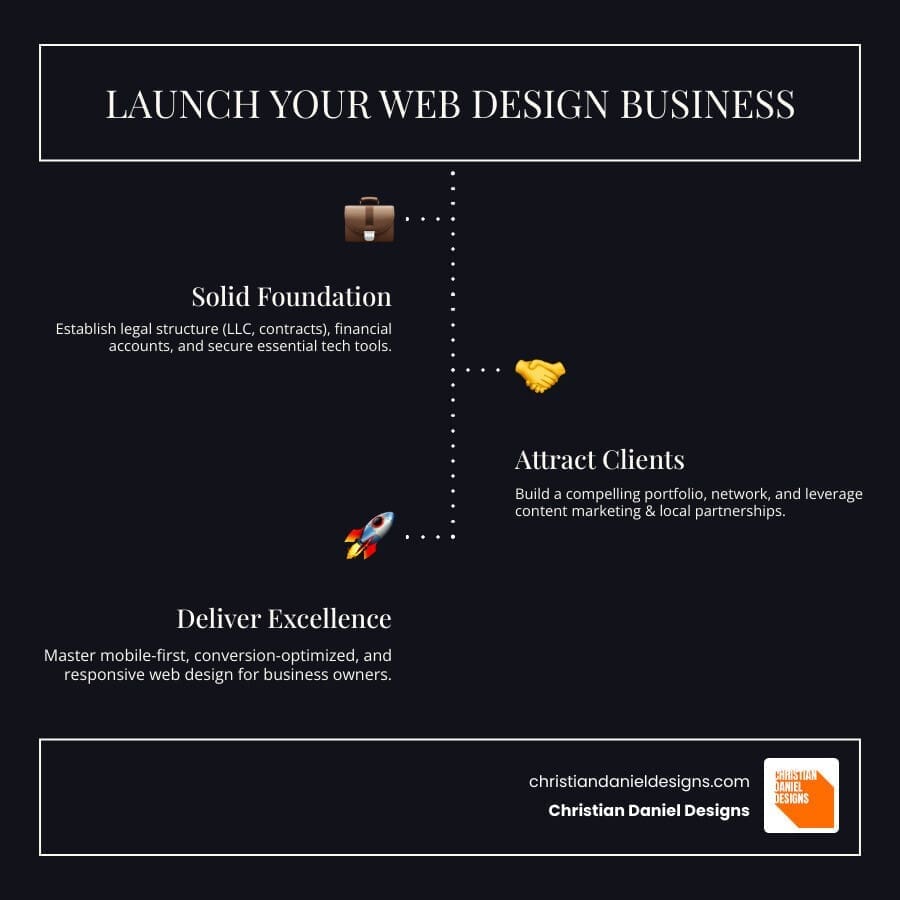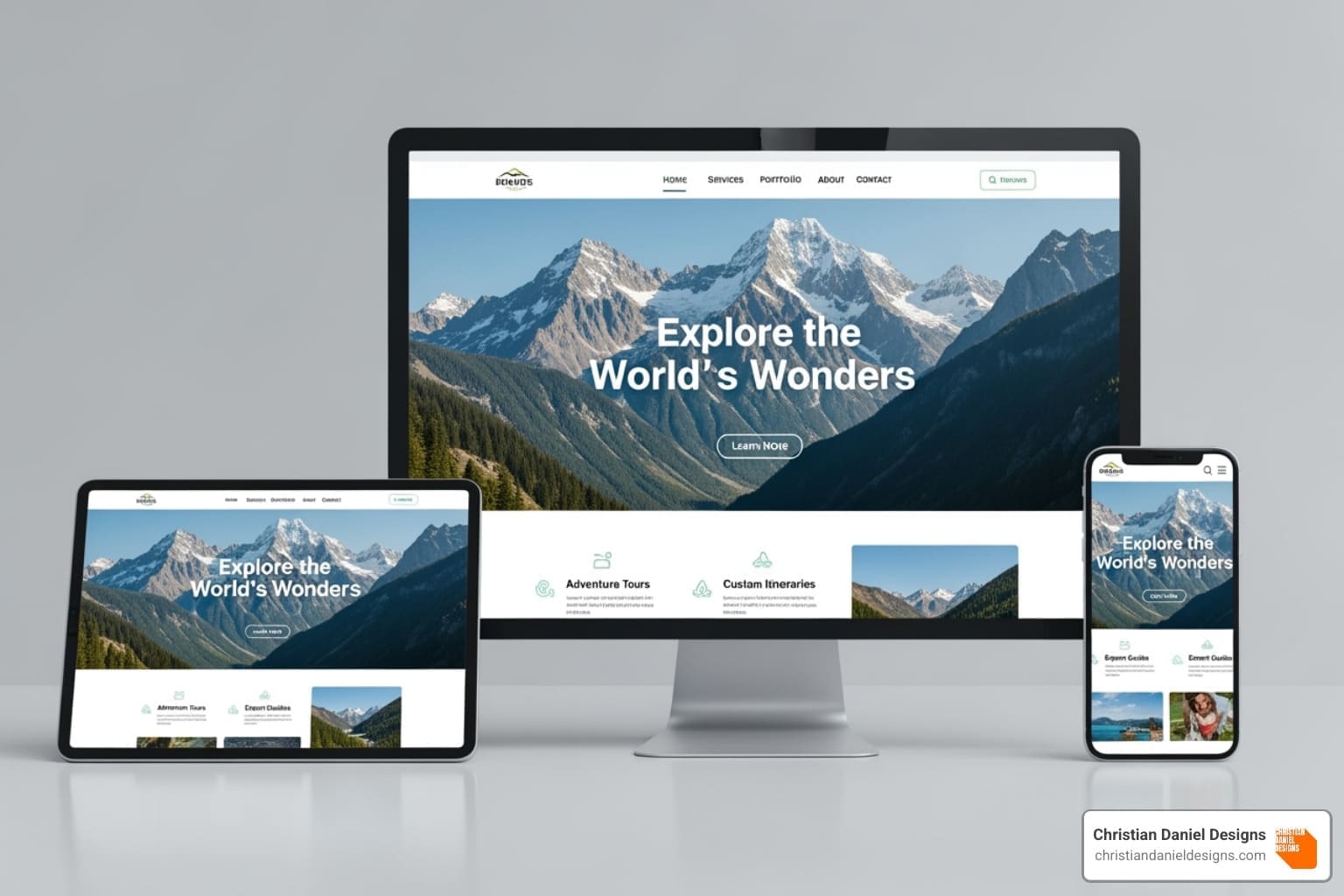Web Design for Business Owners: 5 Steps to Thrive in 2025
Why Web Design for Business Owners is a Goldmine Opportunity
Web design for business owners is a highly in-demand service. Small businesses need professional websites that convert visitors into customers, but most lack the time or expertise to build them.
Quick Answer: Starting a web design business for small business owners involves:
- Legal Setup: Form an LLC, get proper contracts, hire a CPA
- Essential Tools: Computer, design software, project management tools
- Client Acquisition: Build a portfolio, network locally, use content marketing
- Service Delivery: Focus on mobile-first, conversion-optimized websites
- Pricing Strategy: Charge $4,000-$10,000 per website based on complexity
Research shows that 98% of customers start with an online search for local services, yet many small businesses have outdated websites that fail to capture leads.
One pest control company saw its leads increase by 1,700% after a professional website redesign. Another business owner shared: “The new website is directly responsible for our growth and the fact that we have more than doubled our revenue in six months.”
This creates a massive opportunity for web designers. The average business website costs between $4,000 and $10,000, and most businesses see an ROI within 6-12 months.
I’m Christian Daniel, founder of Christian Daniel Designs. With over two decades of experience, I deliver web design for business owners in hospitality, dining, and creative sectors. My award-winning approach combines strategic impact with visual storytelling to turn your online presence into a lead-generating machine.

Setting Up for Success: Legal, Financial, and Tech Essentials
Before diving into design, you need a solid foundation for your web design for business owners venture. Let’s cover the essential legal, financial, and technical steps for long-term success.
Legal and Financial Setup
Properly establishing your business is crucial, as skipping these foundational steps can lead to serious problems.

Your first decision is forming an LLC or a DBA. An LLC (Limited Liability Company) protects your personal assets from business liabilities, like lawsuits. A DBA (Doing Business As) lets you use a business name but offers no liability protection. For web designers, an LLC is usually the smarter long-term choice, as the extra protection is worth the investment.
Trademarking your business name and logo is another smart move to protect your brand identity from competitors.
Hire a CPA early. A good certified public accountant saves you money and headaches by handling taxes, bookkeeping, and offering financial advice that can save you thousands. Also, open a dedicated business bank account to keep finances separate and avoid confusion at tax time.
Never start work without a signed professional contract. It should clearly outline project scope, payment terms, deadlines, and copyright ownership. A solid contract protects both parties by setting clear expectations and preventing misunderstandings.
Finally, your own website needs proper legal policies, like a privacy policy and terms of use. This is a legal requirement and shows clients your professionalism.
Essential Equipment and Software
A web design business has low startup costs. Your most important tool is a reliable, powerful computer that can handle design software.
For design software, use industry-standard tools like Adobe Creative Suite (Photoshop, Illustrator, XD) or the popular collaborative tool, Figma. For development, you’ll need a code editor and browsers for testing. Use project management software like Asana or Trello to stay organized and communicate with clients.
Some equipment can lift your professional game. A great second screen like an Apple iPad is versatile for notes or sketching, especially with a tool for sketching like an Apple Pen. Since client interaction often happens over video, invest in a professional webcam for client calls. A professional appearance on video builds trust.
Set up a reliable backup system immediately using cloud storage or external drives. Losing client files can be catastrophic for your business. Start with the essentials and upgrade as your business grows. Reliable tools are key for important client projects.
Building Your Clientele: Proven Marketing and Sales Strategies
Great design skills aren’t enough; you need a proactive marketing and sales approach. We’ve spent two decades honing strategies to attract clients who value quality web design for business owners.

A compelling portfolio is your most powerful marketing tool. When starting, use personal projects like mock-ups for local businesses or redesigns as case studies to build credibility. Referrals are the backbone of business growth, so encourage them by delivering exceptional service and maintaining client relationships.
Networking at local chamber of commerce meetings and industry events puts you face-to-face with potential clients. Content marketing, through blogs and case studies, positions you as an expert, helps with SEO, and builds trust. Learn more in our guide on How to Attract Website Visitors.
Effective Online Marketing Channels
A strategic online presence is key to attracting quality leads. Blogging for SEO attracts business owners searching for solutions. Write helpful articles on topics like “Why Your Small Business Needs a Mobile-Friendly Website” to bring in qualified prospects.
Your social media presence should showcase your expertise and personality. Use Instagram for visual before-and-afters and LinkedIn to connect with business owners. In niche Facebook groups, be genuinely helpful by answering questions and sharing insights without self-promotion. Providing value builds recognition and trust.
Building authority happens through consistent demonstration of expertise. Every interaction—blogging, social media comments, or speaking at events—is an opportunity to showcase your knowledge and build trust.
Successful Client Acquisition Strategies
Proactive strategies are needed to turn prospects into clients. Cold outreach can work if done thoughtfully. Research local businesses with outdated sites and send a personalized message offering a free audit. This approach helped one client increase leads by 1,700%.
Warm networking leverages your existing relationships. Let friends, family, and former colleagues know about your business. Partnering with other local businesses like marketing consultants or photographers creates a steady stream of referrals.
Offering free consultations removes risk for potential clients. A 20-30 minute call lets you demonstrate expertise and show them the value of professional web design for business owners.
Collect detailed testimonials and social proof after each project. Display these case studies prominently on your website and use them in sales conversations. Success stories are your most persuasive marketing tool.
The Core Service: Mastering Web Design for Business Owners
Exceptional web design for business owners is more than aesthetics; it’s about achieving fundamental business goals: attracting customers, boosting sales, and building a trusted brand.

Small business owners need websites that work as hard as they do. We focus on ROI for our clients, measuring success by tangible results like doubled reservations or a surge in qualified leads. Our approach to Web Design for Small Businesses delivers maximum impact within realistic budgets, because a website is a critical first impression.
Key Principles of Effective Website Design for Small Businesses
The most successful websites share fundamental characteristics. It’s not about trends, but about clarity and purpose.
Simplicity wins. We focus on simple, fresh, and unique designs that cut through the noise and reflect your specific brand. Brand consistency is also crucial. Every element—color, font, imagery—should tell a cohesive story across all touchpoints.
A professional design builds trust and credibility. As research shows, a professionally designed website exudes credibility, which leads to more customers. Your homepage must be a clear, compelling elevator pitch that immediately answers “What’s in it for me?”
User Experience (UX) and UI Best Practices for web design for business owners
User experience (UX) is what separates a pretty website from one that drives results. We start by mapping the user journey to understand customer goals and design a path that guides them smoothly toward action.
Easy navigation and a simple structure are business necessities. We apply principles from The Laws of UX to create intuitive interfaces. For example, Hick’s Law reminds us to limit choices to prevent decision paralysis. We also leverage natural reading patterns (like F-shaped and Z-shaped patterns) to place important information where users’ eyes naturally go.
Mobile-first design is foundational. With billions of smartphone users, a site must work flawlessly on mobile. Accessibility is also smart business. Our commitment to ADA Compliant Web Design ensures inclusivity and expands your audience.
Essential Elements and Content Strategy for web design for business owners
Successful websites have key elements implemented effectively. Key pages include: a homepage that communicates your value proposition; an About Us page to build a human connection; and a services/products section focused on benefits, with professional visuals.
Contact information must be easy to find on every page. Strong calls-to-action (CTAs) guide visitors to the next logical step. Content planning and SEO-friendly copy are also vital. Since visitors skim, we use powerful headlines and concise copy to drive action.
Finally, a compelling Portfolio showcases your work and demonstrates the quality of your web design for business owners services.
Common Pitfalls and How to Avoid Them
Starting a web design business has potential pitfalls. After two decades in the industry, we’ve seen many avoidable mistakes. Knowing what to watch for can prevent them.

A common mistake is jumping in without market research. Don’t assume clients will just appear. Understand your local market, identify ideal clients, and research their actual needs before you start marketing.
Skipping contracts is a costly error. Every project, no matter how small, needs a signed contract to protect both parties by outlining scope, payment, and deliverables.
Hand in hand with contracts is the rule to always take deposits. A deposit (typically 25-50%) ensures client commitment and covers initial costs. Never deliver final files or launch a site until you receive full payment. Your work is valuable intellectual property.
Poor client communication can ruin your reputation. Set clear expectations for response times and milestones, and send regular updates to maintain a good relationship.
Avoid designing only for today’s needs. Always design with scalability in mind, creating websites that can grow with the client’s business. This provides better value and can lead to future work.
Underpricing services is a damaging long-term mistake. You’re selling a business solution that delivers significant value, like the 1,700% lead increase one of our clients saw. Price accordingly.
Finally, don’t let fear of asking for help hold you back. Join business groups, find a mentor, or hire a coach. Outside perspectives help you avoid mistakes and accelerate growth. Avoiding these pitfalls will keep you on the right path. The key is to learn from mistakes and move forward with confidence.
Frequently Asked Questions about Starting a Web Design Business
Here are answers to common questions about starting a business in web design for business owners, based on our two decades of experience.
How much should I charge for a small business website?
Most business websites cost between $4,000 and $10,000, with complex custom builds costing $20,000 or more. Pricing depends on project complexity, the number of pages, and the level of customization. Factors like content creation and ongoing maintenance plans also add value and affect the price.
We recommend value-based pricing. Focus on the ROI you deliver. A website that generates thousands in new revenue makes a $7,000 investment a logical choice. Understanding your value is key to confident pricing, even though average costs vary by market and scope.
What’s the difference between web design and web development?
Web design focuses on the visual and user experience (UX). It involves creating wireframes and mockups, choosing colors and fonts, and ensuring the site feels intuitive and captures the brand’s personality.
Web development uses code to bring designs to life. Front-end developers build the user-facing side with HTML, CSS, and JavaScript. Back-end developers manage the server, database, and technical infrastructure.
For simple projects, one person might do both. For complex sites, we collaborate with specialized developers to ensure top-notch visual and technical performance. As you grow, decide if you want to specialize or build a full-service team.
Should I use website builders for my clients?
This depends on the client’s needs and business goals. Website builders are user-friendly and cost-effective for basic needs, but they have drawbacks: limited customization, scalability issues for growing businesses, and vendor lock-in, which makes migrating away difficult. Template-based sites can also look generic, hurting a brand’s credibility.
We usually recommend custom solutions because they offer unique branding, optimized performance, and complete control. For example, our Custom Hotel Websites require integrations and brand experiences that builders can’t provide.
In our 20+ years of experience creating award-winning web design for business owners, we’ve found that while builders have a place for basic needs, custom solutions deliver the standout, results-driven websites that lift a brand.
Conclusion
Starting a web design business is an opportunity to help entrepreneurs succeed. This guide covered the essentials: legal setup, tools, client acquisition, and delivering results-driven web design for business owners.
The impact is significant. You’re not just building websites; you’re creating solutions that transform businesses. A strategic website can double revenue or, like one of our clients, increase leads by 1,700%. That’s the change you can deliver.
Demand for quality web design for business owners is surging. A website is a powerful sales tool, not just a brochure. With 98% of customers searching online, a poor website sends customers to competitors.
Focusing on the fundamentals—professional practices, strategic design, and client partnership—will help you build a profitable and meaningful business. Small business owners need a partner who understands their challenges and can deliver digital success.
Every successful business starts with a first client. With our 20+ years of experience, we’ve seen many designers grow into confident, in-demand professionals. The path ahead is exciting, challenging, and incredibly rewarding. You have the roadmap, the strategies, and now it’s time to take action.
Ready to build a thriving web design business? Explore our professional Services to see the quality we deliver and get inspired for your own journey ahead.